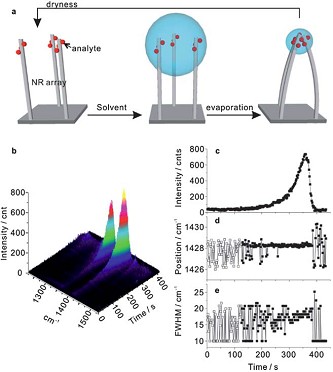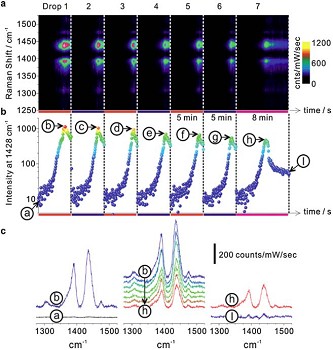An important progress on constructing reversible surface-enhanced Raman scattering (SERS) hotspot was achieved by Prof. Jinhuai Liu and Prof. Liangbao Yang from Nano-materials & Environmental Detection Laboratory. The result has been published in “Chemical Science”(Capillarity-constructed reversible hot spots for molecular trapping inside silver nanorod arrays light up ultrahigh SERS enhancement, Chemical Science, 2013, 4: 3490-3496), and Dr. Honglin Liu is the first author of this article. The researchers found that SERS hotspots with outstanding enhancement ability can spontaneously form in a reversible andreproducible way by the self-approach of flexible silver nanorods driven by the capillary force of solventevaporation, and at the same time the target analytes can be trapped in the top-closed silver nanorodsin the solvent evaporation process. The Raman intensity of the top-closed vs. top-opened nanorodarrays was a factor of 100–1000 higher for SERS reporters such as p-aminothiophenol or crystal violet.Furthermore, triplicate measurements on long nanorod arrays at the same position show a variation ofthe Raman intensity <10%, demonstrating a good reproducibility of the enhancement. Moreover, the self-approach is highly dependent on the nanorod length and the molecules withdifferent adsorptivity have different SERS performance in the solvent evaporation process. This solventevaporation-controlled self-approach is an extremely simple and efficient strategy for the spontaneousformation of Raman hot spots with outstanding enhancement ability. These characteristics promise ageneric platform for molecule trapping and SERS sensing with high sensitivity and reproducibility, whichcan help to transform SERS into a practical analytical technique. This work was supported by the National Basic Research Program of China (2011CB933700), the National InstrumentationProgramof China (2011YQ0301241001 & 2011YQ0301241101), NationalNatural Science Foundation of China (21271136), and NaturalScience Foundation of Anhui Province (1308085QB27).

Schematic principles for reversible self-approach of the nanorodsdriven by the capillary force of solvent evaporation 
Reproducibility:Time-course SERS mapping of a specific point on the NR array-L for anumber of consecutive cycles of evaporating 50 mL ethanol using 1nMPATP as the SERS reporter
The Article Link: http://pubs.rsc.org/en/Content/ArticleLanding/2013/SC/c3sc51231b |
